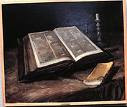 This painting by Caravaggio (1571 – 1610) of Saint Jerome deep in study surely is one the painter’s best examples of his use of deep, rich colours and his attention to detail.
This painting by Caravaggio (1571 – 1610) of Saint Jerome deep in study surely is one the painter’s best examples of his use of deep, rich colours and his attention to detail.Why most renditions of Saint Jerome by painters and illustrators find him in his study is that he was commissioned by Pope Damasus the 1st to revise the Latin text of the Bible, known as the ‘Vulgate’ that is still in use today.
Saint Jerome was born to a pagan family circa 365 C.E., to later study the law and become a lawyer. He soon later changed his subject of study to theology where his true conversion to Christianity occurred. He was also baptised around this time.
Saint Jerome is not so much remembered for his scholarly works but for the incident where he came upon a lion with a thorn in its paw. He removed the thorn without any protest from the king of beasts…and as legend has it, the lion remained at Saint Jerome’s side for many years.
He lived the last thirty years of his life in the Holy Land more or less a recluse, continuing to translate texts, write prayers, biographies and collected a vast library of scrolls.
Because he was a scholar of the Church, his patronage include: archaeologists, archivists, Bible scholars, librarians, translators and school children.
Saint Augustine said about Saint Jerome:
What Jerome is ignorant of, no man has ever known.
Caravaggio’s life was short though full. To my way of thinking he was a true genius with a hot temper, a love affair with alcohol, and was often described as “extremely crazy”.
This painting is not one of his best however reveals his genius for colour and “realism”; now considered the founder of the Baroque period where his emphasis on deep shadow contrasting blinding light is the art movement’s definitive trademark, so to speak, and made him famous at the time.
Some art scholars have written that it was only in the early twentieth century that Caravaggio’s work had come back into vogue. I find this astonishing considering the man’s genius.
This painting of Saint Jerome has to be one of my favourites of the artist’s entire body of work.


No comments:
Post a Comment